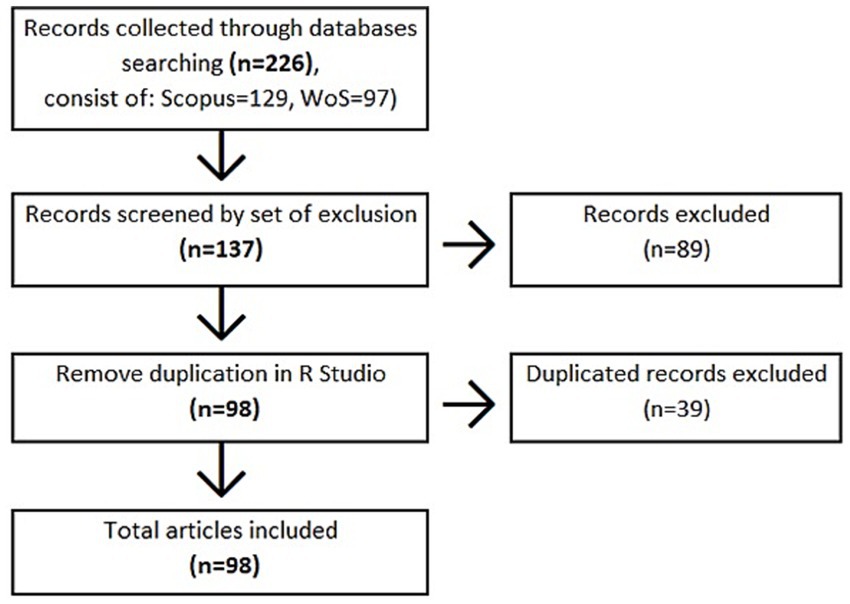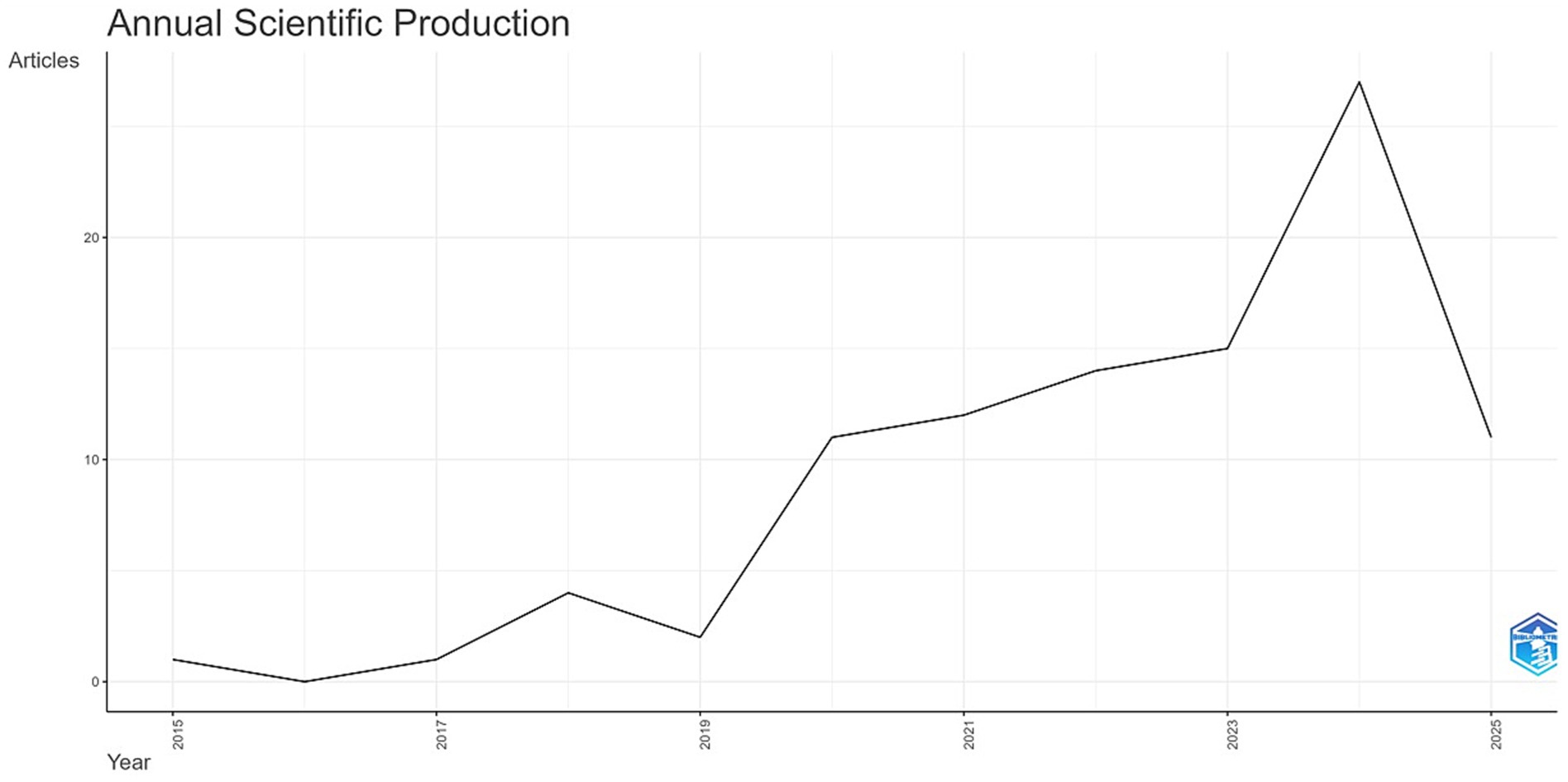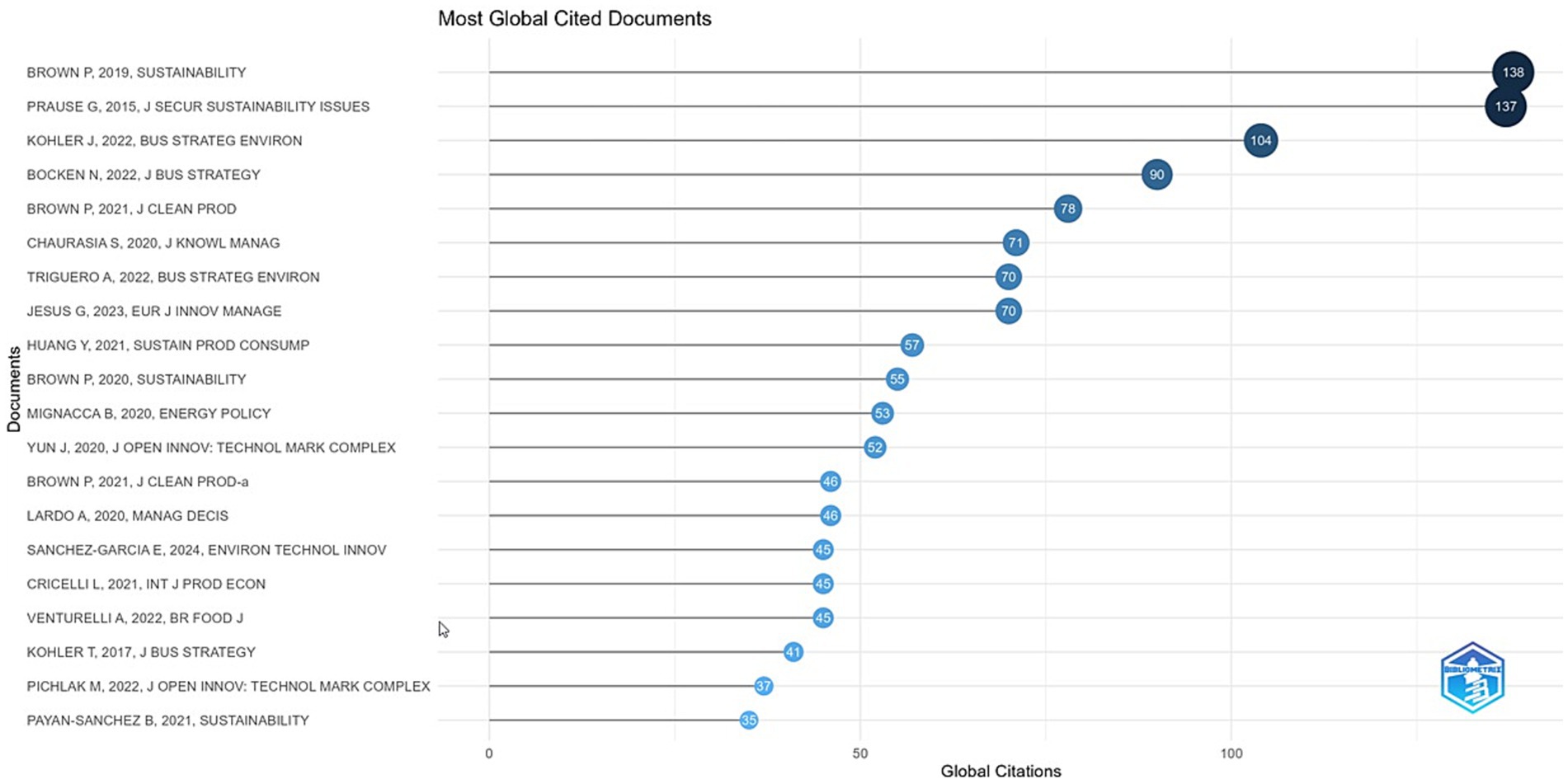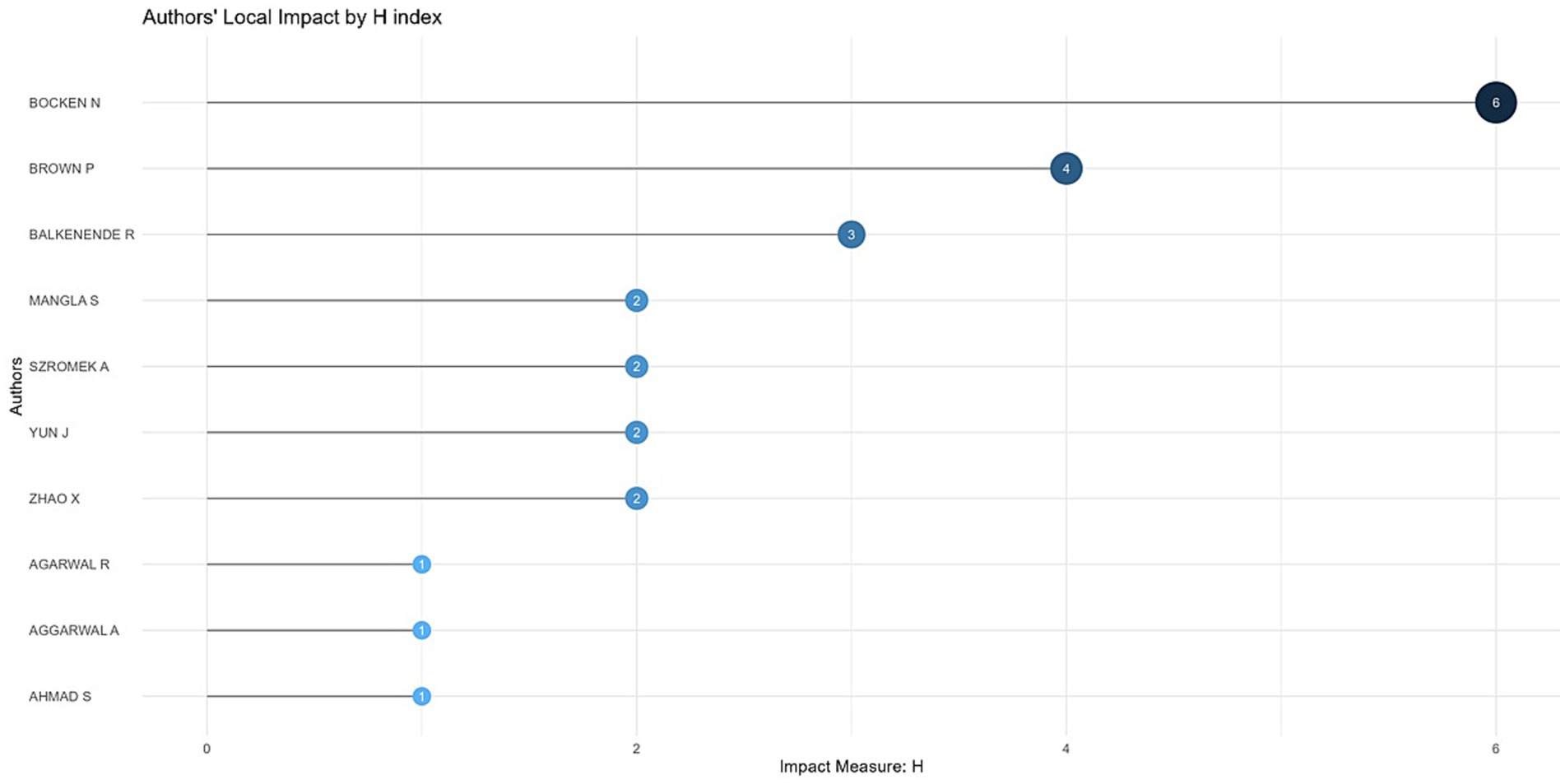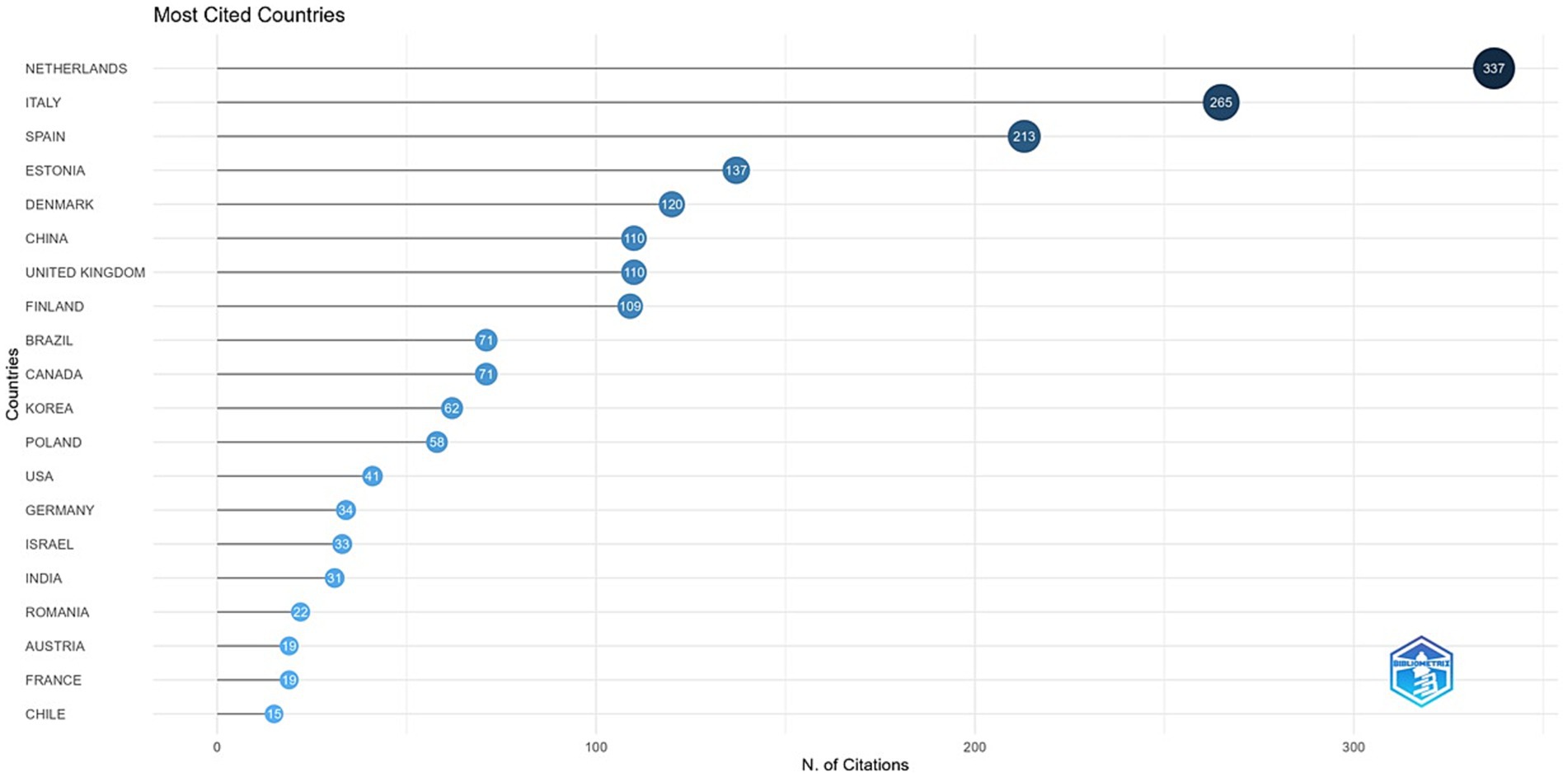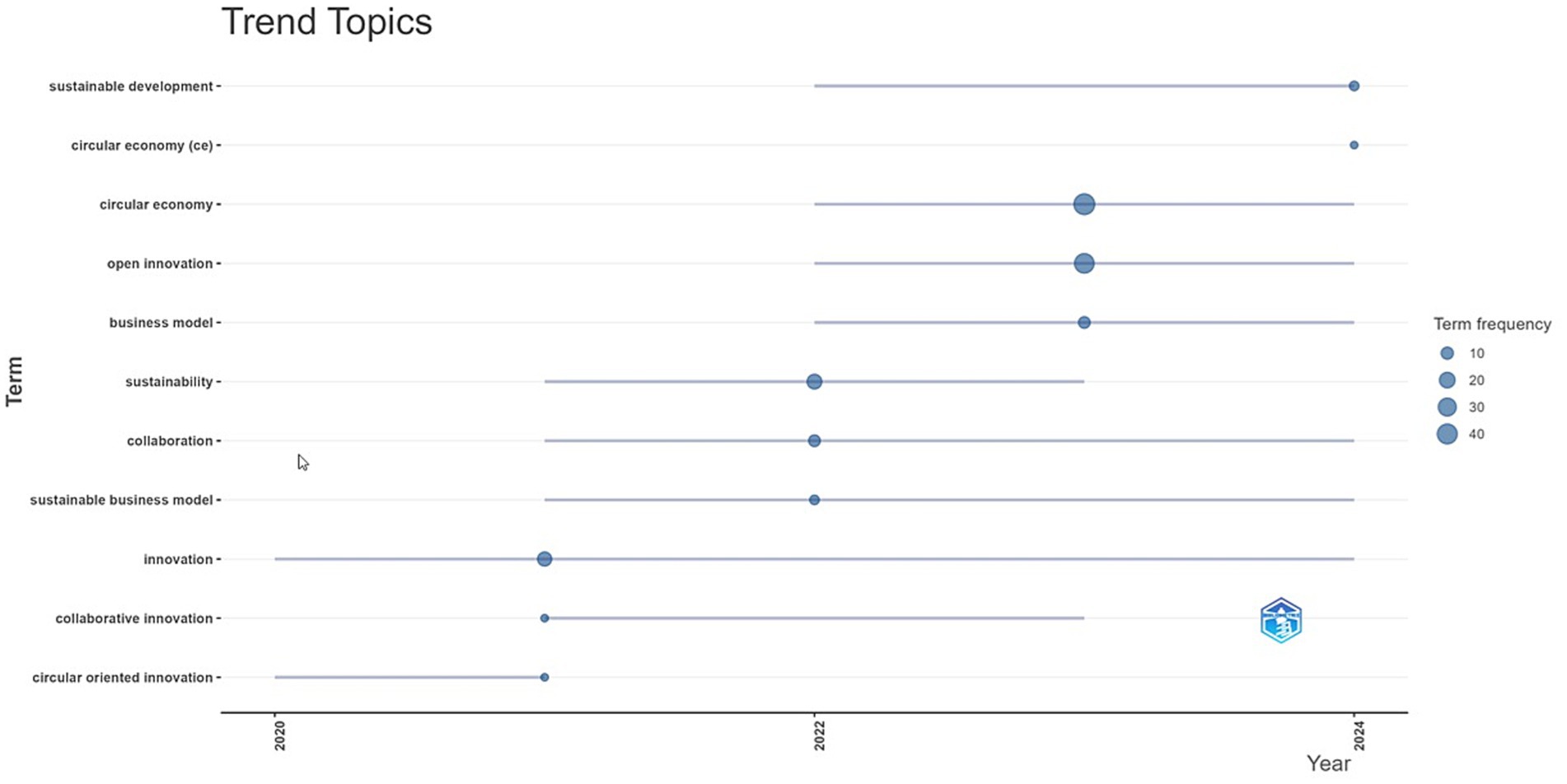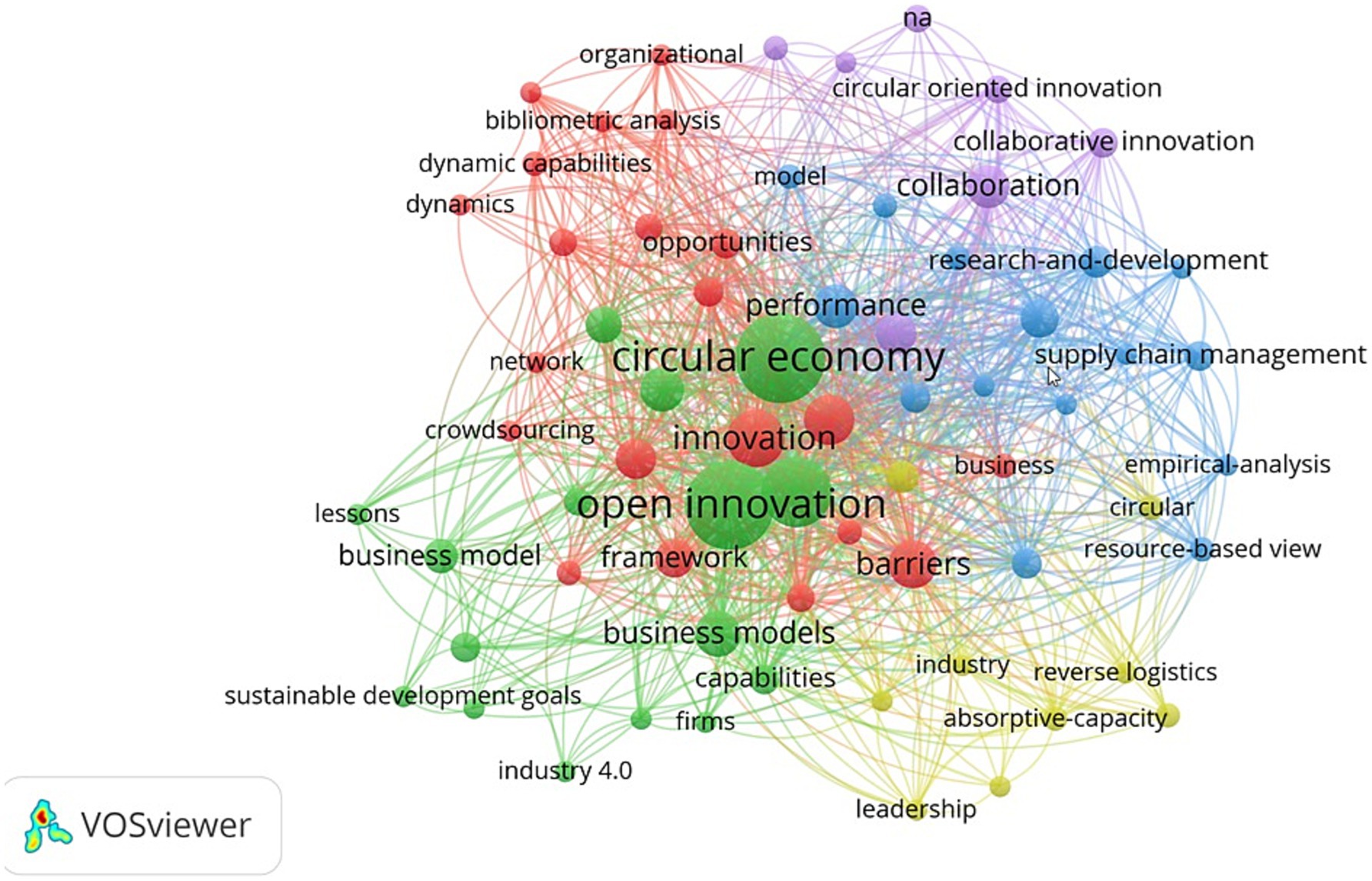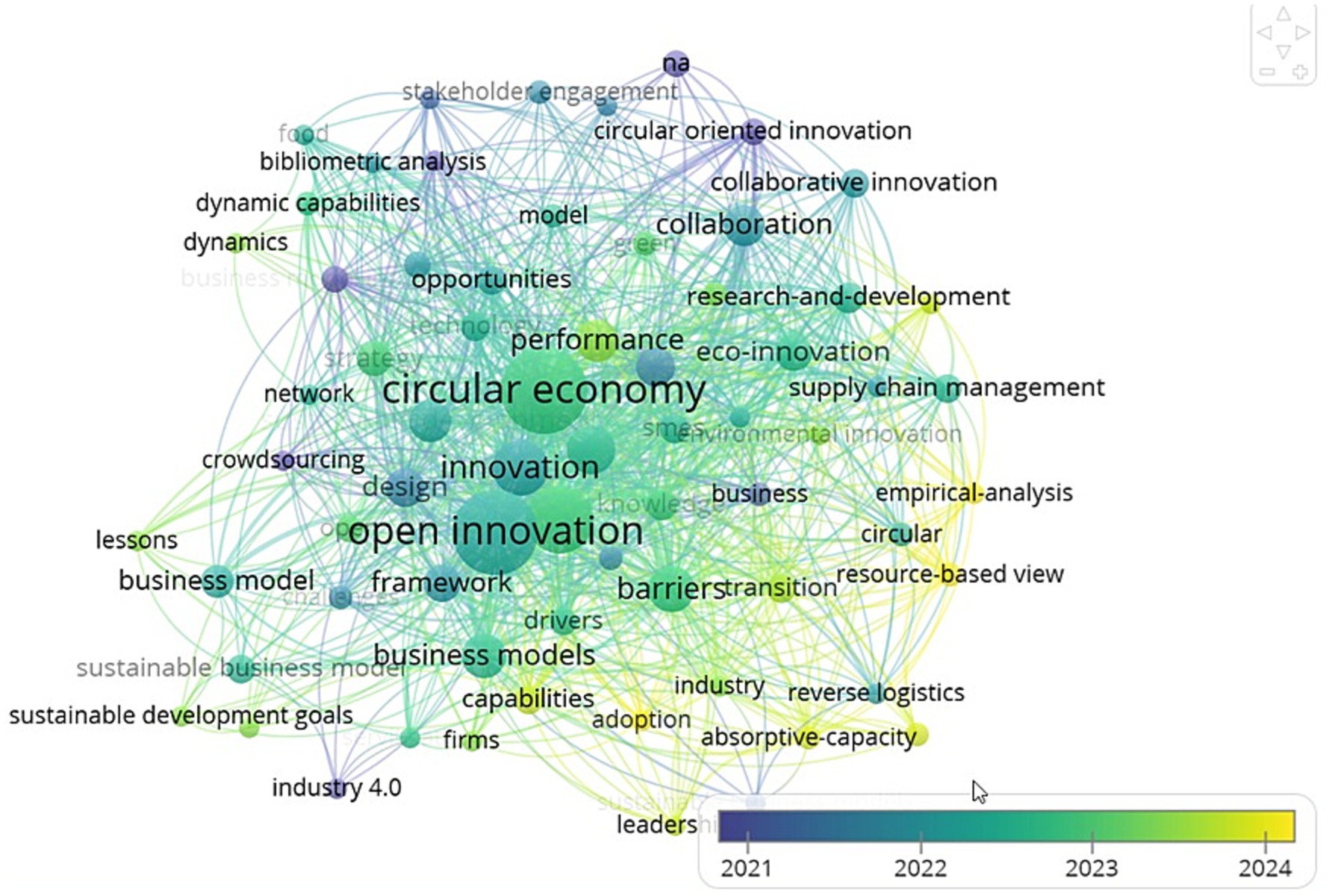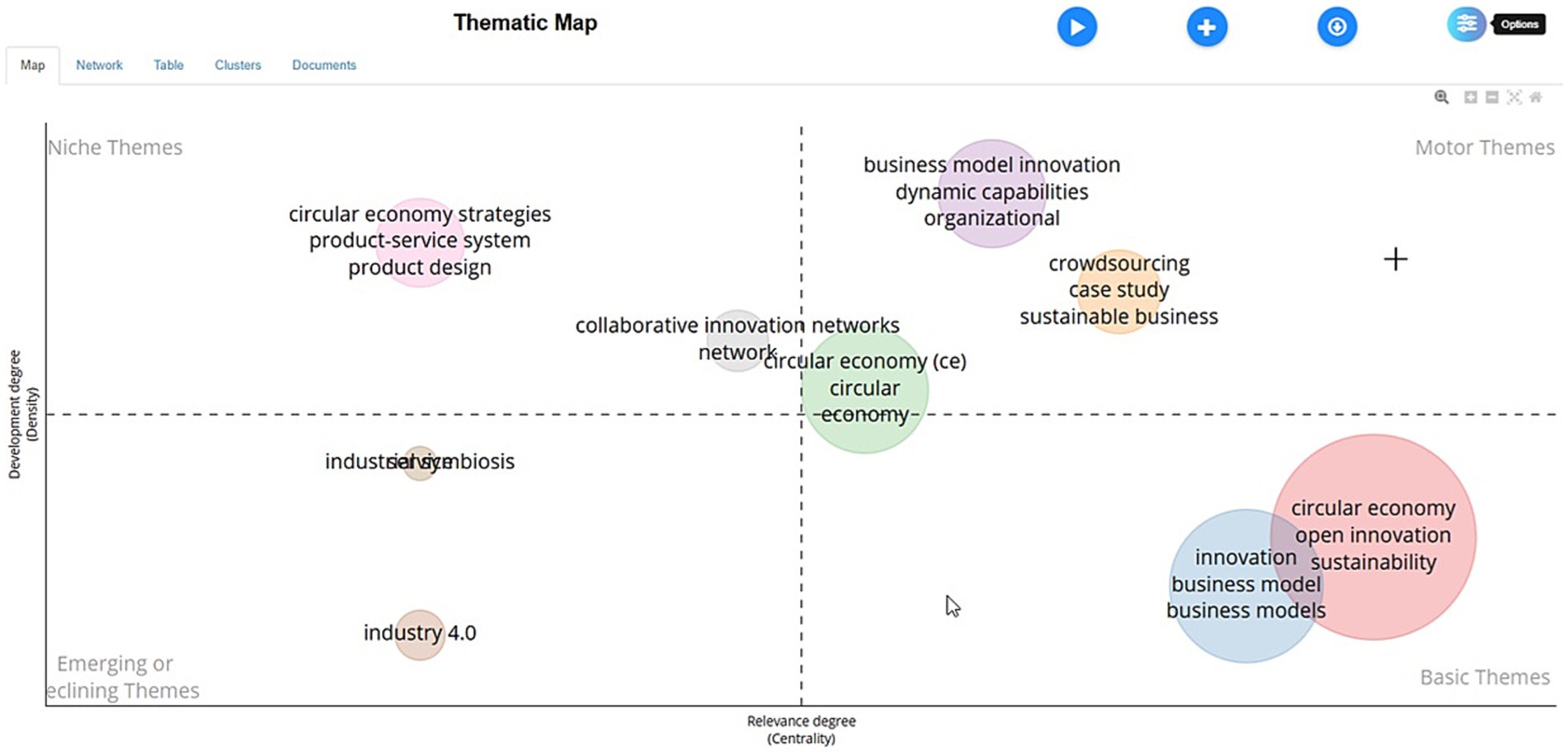- Management Department, BINUS Business School Doctor of Research in Management, Bina Nusantara University, Jakarta, Indonesia
The urgency of environmental and resource-related challenges has elevated the importance of integrating Open Innovation and Circular Economy into sustainability-driven strategies. While these domains have independently matured, their intersection remains under examined, particularly from a quantitative, science-mapping perspective. This study employs bibliometric analysis on 98 articles published in academic journals between 2015 and 2025, which were screened according to specific criteria, using the Scopus and Web of Science databases. The performance analysis and science mapping were conducted using R and VOSviewer to understand the intellectual organization, changing themes, and influential researchers in the Open Innovation–Circular Economy field. The results contribute theoretically to how Open Innovation mechanisms can facilitate Circular Economy transitions by highlighting underutilized theoretical perspectives, such as stronger innovation capability, better engagement with all stakeholders, and greater organizational capability, and practically, it offers insights for organizations, policymakers, and other ecosystem actors seeking to implement circular strategies through open and collaborative innovation. Conversations are now shifting from theory to more practical and digitally driven approaches that apply to entire ecosystems. Technologies such as artificial intelligence, the Internet of Things, and digital twins are increasingly instrumental in supporting circular models and real-time decision-making. This study utilizes the Scopus and Web of Science databases, which may result in the exclusion of grey literature and studies from specific regions that are not indexed. In the future, research should include data from different sectors, develop designs such as Open Circular Platforms, and test concepts such as Circular Openness and Innovation Density.
Introduction
Although there is no consensus on the definition of Open Innovation as a paradigm enabling firms to leverage internal and external ideas and market pathways for improving their innovation capabilities, Open Innovation first originates from the open field of its responses to the closed R&D model, focusing on organizational boundaries permeability and the relevance of interorganizational knowledge flows (Eisenreich et al., 2021; Payán-Sánchez et al., 2021). In the early 2000s, Open Innovation, as initially proposed by Chesbrough (2003), was based on the notion of deliberately utilizing internal and external flows of knowledge to achieve rapid innovation (Payán-Sánchez et al., 2021). This foundational premise provided a good response to the deficiencies of closed innovation systems, particularly in addressing complex sustainability challenges. Besides, Circular Economy is a systemic approach to structural development of the economy in which priority is given to minimization of waste, regeneration of resources and construction of sustainable material cycles, which differs from the conventional linear model of “take–make–dispose” (Bocken and Ritala, 2021; Pichlak and Szromek, 2022). However, the linear production system has been replaced by the Circular Economy framework, which encompasses resource regeneration and the elimination of systemic waste.
Open Innovation has evolved beyond the focus on internal, sophisticated technological capabilities to a transdisciplinary application in the emerging multi-industry sectors, such as business model innovation and sustainability. The evolution of this is evident in the development of a collaborative framework that embeds many stakeholders in the co-creation of circular solutions (Jesus and Jugend, 2021; Eisenreich et al., 2021). Open Innovation has been further extended to other areas, such as environmental management and smart manufacturing, through the application of digital technologies and Industry 4.0 capabilities, serving as a driver of sustainable practices (Krmela et al., 2022). This transition is because innovation is increasingly viewed as a system, a networked process involving a diverse group of actors. More recent research has highlighted the importance of collaboration networks, digital infrastructure, and a conducive policy context (e.g., Eisenreich et al., 2021; Jesus and Jugend, 2021; Krmela et al., 2022) in crafting strategies for innovation focused on sustainability goals. Therefore, Open Innovation has become an enabler of circular business models that create new value and competitive advantage (Payán-Sánchez et al., 2021; Bocken and Ritala, 2021).
The notion expressed in terms of the convergence of Open innovation and circular economy in academic discourse symbolizes a shift in sustainability and innovation research discourse, as the literature has begun to raise topics and focus on how Open Innovation addresses the possible adoption of Circular Economy principles. Based on this, researchers began to explore how open and collaborative innovation models could overcome barriers to circular transition—specifically, technological lock-in and organizational inertia (Jesus et al., 2024; Sergianni et al., 2024). Early theoretical discussions highlighted the complementarity between Open Innovation’s boundary-spanning mechanisms and the focus on closed-loop systems of the Circular Economy (Perotti et al., 2024). In the very long run, this discourse became more empirical and operational in focus. Some studies showed that Open Innovation is neither merely a bridge between theories nor simply a means to advance Circular Economy; rather, it acts as a pragmatic enabler of Circular Economy and an enabler of both the co-creation and scaling of circular solutions over different industrial sectors (Perotti et al., 2024; Calabrese et al., 2024).
One of the developments in this evolving research stream can be traced out in the slow and steady transition from market to network-based models of innovation. The early research focused on individual firm-level innovation activities characterized through external licensing or joint ventures (Rahmat et al., 2024). With the increasing importance of the sustainability agenda in corporate strategy, the focus shifted to collaborative networks, which enabled systemic change (Calabrese et al., 2024). The study argues that a transition is occurring from the dissemination of knowledge along value chains to the inclusion of multiple stakeholders and ecosystem management as crucial enablers of circular innovation. At the same time, technological advancements under the Industry 4.0 umbrella reinforced the Open Innovation-Circular Economy nexus. Following Jesus et al.’s (2024) empirical findings, technologies such as the Internet of Things, big data analytics, and cyber-physical systems mediate the effectiveness of Open Innovation in supporting the Circular Economy. These technologies are utilized to transfer knowledge more effectively, automate circular processes, and establish dynamic feedback loops that enhance the scalability and flexibility of circular models (Perotti et al., 2024; López-Pérez et al., 2023).
Recently, things have changed, and we have been focusing on how strategic differentiation of circular business models can be achieved through open innovation practices. For example, Perotti et al. (2024) distinguish supply chain-based and ecosystem-oriented circular collaborations. Finally, their findings underscore that as organizations mature in their circular innovation practices, they pass through a transition from centralized, hierarchical coordination and collaboration towards more distributed, inclusive, and technology-enabled collaboration. At the same time, Pichlak and Szromek (2022) provide theoretical robustness of the Open Innovation-Circular Economy integration by advancing conceptual frameworks of eco-innovation in closed-loop production models. Taken together, these insights suggest that a pedagogical structure exists through which the fields of open innovation and the circular economy have emerged in educational pathways, progressing from theoretical constructions to empirical verification. These milestones extend beyond being points of an increasingly sophisticated theoretical understanding and have reflected an increased practical significance, with the ever more intertwined notions of openness in innovation and circularity principles. As numerous studies are emerging that highlight the operational mechanisms and strategic implications of integration events, all of these point to the likelihood that this will indeed be realized.
The Circular Economy is very heavily dependent upon collaboration and stakeholder engagement. Typically, for effective circular business models, there are many actors, including suppliers, recyclers, customers, and policymakers, that bring knowledge and resources (Perotti et al., 2024). All of these networks support technological innovation, best practice sharing, and enhanced circularity system-wide. Along with this, digital technologies enhance collaboration through improvements in supply chain transparency, the use of data for decision-making, and the optimization of resource flows (Johnstone, 2024). Collectively, the elements of Open innovation and circular economy together promote sustainable economic systems that bring about the confluence of profitability and environmental stewardship. Although the academic and empirical literature on this matter is fragmented, a review of this nature is necessary not only to consolidate findings but also to clarify research lines.
The research examines Open Innovation relationships with the Circular Economy through the Scopus and Web of Science (WoS) databases, implements inclusion and exclusion criteria, and merges selected articles before eliminating duplicate entries using the bibliometric software R Studio. Bibliometric analysis tools within the review structure organize the information and identify trends to reveal Open Innovation mechanisms that enable progress in the Circular Economy across sectors, disciplines, and geographical areas. This study aims to demonstrate through assessment that Open Innovation serves as a stimulant factor accelerating the advancement of Circular Economy practices (Jesus and Jugend, 2021; Sergianni et al., 2024; Jesus et al., 2024). The research analyzes academic literature to demonstrate that Open Innovation drives three fundamental enablers for improved circular system implementation: innovation capability, better stakeholder connections, and organizational adaptive capacity (Hernández-Chea et al., 2020; Runiewicz-Wardyn, 2023; Eisenreich et al., 2021; Sgambaro et al., 2024). This review provides practical solutions in addition to theoretical knowledge by visualizing the Open Innovation-Circular Economy domain structure and thematic path, which benefits researchers, practitioners, and policymakers working on sustainability transformations (Calabrese et al., 2024; Ahmad et al., 2024).
Open Innovation, combined with the Circular Economy, brings vital prospects for developing sustainable development. The combination of the Open innovation and circular economy frameworks leads to the establishment of strong economic systems that support the integration of other dimensions and all economic paradigms while maintaining a commitment to environmental sustainability (Álvarez-Meaza et al., 2020; Brown et al., 2020). The realization of this potential depends on building comprehensive knowledge about research in this domain. Pichlak and Szromek (2022) underscored the timeliness of collaborative work among stakeholders, who are typically businesses and the community, for effective, sustainable transition (Pichlak and Szromek, 2022; Mamedova et al., 2022). Research results will demonstrate the primary concept that Open Innovation serves as an enabler for circular model growth by enhancing cooperation mechanisms, accelerating technology adoption, and generating value across diverse ecosystems (Yun and Zhao, 2020; Lisi et al., 2024; Sondhi et al., 2024).
Despite growing interest in open innovation and the circular economy, research at their intersection remains fragmented and lacks theoretical integration. This study addresses this gap by conducting a systematic review with bibliometric analysis (2015–2025), offering a comprehensive mapping of the field. Its marginal contribution lies in consolidating dispersed knowledge, identifying key thematic clusters, and uncovering emerging trends such as digital platforms and innovation ecosystems. By clarifying the intellectual structure and revealing underexplored areas, this study provides a structured foundation for future research and practical insights to guide circular strategies through open and collaborative innovation. The main objective of this study is to secure the role of Open Innovation to advance the Circular Economy, in particular in addressing:
1. How has the relationship between open innovation and circular economy developed, and how did Open Innovation impact the success of Circular Economy models?
2. What are the key drivers and barriers for integrating Open Innovation in Circular Economy practices?
The rest of the article is structured as follows: the next section presents the Materials and Methods, followed by the Results section, then the Discussion, and finally the Conclusion, which outlines the contributions, limitations, and directions for future research.
Materials and methods
Comprehensive academic databases are the primary sources for retrieving high-quality peer-reviewed literature at the intersection of Open Innovation and Circular Economy. Scopus and Web of Science (WoS) (Birkle et al., 2020) are well known for their broad scope, comprehensive references, and ability to focus on specific points. Payán-Sánchez et al. (2021) and Ahmad et al. (2024) note that both databases represent a wealth and richness of literature from multidisciplinary journals and elite research outputs. The study describes a search for articles focused on the Open innovation and circular economy domains, using the Scopus and Web of Science databases.
A systematic search was conducted in the Scopus and Web of Science databases, using the query below, across titles, abstracts, and keywords. The search was limited to peer-reviewed journal articles published between 2015 and 2025 in the English language. After removing duplicates, the remaining articles were screened based on relevance, resulting in a final dataset of 98 documents for bibliometric analysis using VOSviewer and Bibliometrix. The process is shown in Figure 1. It is crucial to establish a precise definition of search terms, enabling the identification of relevant studies for this research. In this study, a set of targeted search terms has been defined between the Scopus and Web of Science (“Open Innovation,” “Collaborative Innovation,” “Circular Economy,” “Sustainable Business Models”), focusing on their occurrence in titles, abstracts, and author keywords. The search was conducted across various fields, including business, environment, engineering, social science, management, environmental engineering, industrial engineering, green sustainability, and economics. The complete query in Scopus that was used to construct the dataset is the following:
(TITLE-ABS-KEY ("Open Innovation" OR "Collaborative Innovation") AND TITLE-ABS-KEY ("Circular Economy" OR "Sustainable Business Models")) AND PUBYEAR > 2014 AND PUBYEAR < 2026 AND (LIMIT-TO (SUBJAREA, "BUSI") OR LIMIT-TO (SUBJAREA, "ENVI") OR LIMIT-TO (SUBJAREA, "ENGI") OR LIMIT-TO (SUBJAREA, "SOCI")) AND (LIMIT-TO (DOCTYPE, "ar")) AND (LIMIT-TO (PUBSTAGE, "final")) AND (LIMIT-TO (SRCTYPE, "j")) AND (LIMIT-TO (LANGUAGE, "English"))
While for Web of Science, the following query has been used:
TS=("Open Innovation" OR "Collaborative Innovation")
AND TS=("Circular Economy" OR "Sustainable Business Models")
AND PY=(2015-2025)
AND DT=("Article")
AND (WC=("Environmental Sciences ") OR WC=("Management”) OR WC=(“Business”) OR WC=(“Engineering, Environmental”) OR WC=("Engineering, Industrial") OR WC=("Social Sciences Interdisciplinary”) OR WC=(“Green Sustainability Science Technology” OR WC=(“Economics”))
AND LA=("English")
Using Scopus, we found 129 articles that initially matched the search terms. After using additional filters—publication range (2015–2025), subject areas (Business, Management, and Accounting, Environmental Science, Social Sciences, Engineering), document type (Article), Publication stage (Final), source type (Journal) and language (English), a total of 69 articles met all the criteria. As for Web of Science, 97 articles were initially retrieved. After using similar filters—publication range (2015–2025), document type (Article), subject areas (Environmental Science, Management, Business, Environmental Engineering, Industrial Engineering, Social Sciences, Green Sustainability Science Technology, and Economics), and Language (English)—a final total of 68 articles satisfied the query conditions.
The quantitative method for evaluating and mapping the research literature is bibliometric analysis. Two main functions are performance analysis and science mapping, which aim to provide a comprehensive view of science development, key actor contributions, and intellectual structure within a research domain. The quantitative evaluation of the productivity and impact of authors, institutions, journals, and countries within the research ecosystem is the primary focus of performance analysis. The view of performance analysis is achieved through metrics such as the number of publications, number of citations, h-index, and total link strength, which identify the most productive and influential key actors in a particular field (Donthu et al., 2021; Payán-Sánchez et al., 2021). For example, this analysis can identify which countries or universities are most frequently published in Open Innovation and the Circular Economy, as well as the primary journals where such topics are published (Calabrese et al., 2024; Razalli et al., 2024). Science mapping attempts to visualize and understand the relationships between concepts and scientific structures within a field of research. Co-authorship analysis (a collaborative network of authors), co-citations (connections among the references that are cited together), bibliographic coupling (reference sources having similarity), and co-words (keywords occurring together). Science mapping is possible using tools such as VOSviewer (van Eck and Waltman, 2010) or Biblioshiny (R package), which can reveal clusters of themes, trends related to research topics, or the evolution of concepts over time (Hernández-Chea et al., 2020; Donthu et al., 2021). These tools enable the capture of critical insights into the structure of the research field and aid in thematic synthesis of knowledge clusters and emerging research trends (Jesus and Jugend, 2021). Biblioshiny, a Bibliometrix tool that facilitates the graphical analysis of bibliometric processes, was introduced by Aria and Cuccurullo (2017).
Combining these two methods leads to a systematic analysis of the research landscape in bibliometric analysis. An assessment of performance in the context of integrating Open Innovation into Circular Economy practices contributes to identifying leading research centers while mapping the science dynamics and conceptual challenges of this approach. These two analyses yield results that can be used as a basis for the conceptual framework, for proposing the next direction of research, and for suggesting policy and managerial implications. Bibliometrics is the application of mathematics and statistical methods to books and other media of communication (Pritchard, 1969). More modern applications of this technique are presented by Donthu et al. (2021) and Qing et al. (2022), where it is regarded as a tool for mapping knowledge structure and tracking the history of development of scientific disciplines.
Articles that match the above criteria, gathered from Scopus and Web of Science databases, were then merged, and duplicates were removed by using the R language (R Studio). Finally, 98 records meet the query criteria and are ready to be analyzed further using bibliometric tools (VOSViewer and Biblioshiny), as shown in Figure 1.
A bibliometric study is based on the co-citation analysis approach. For instance, Razalli et al. (2024) conducted a bibliometric analysis to chart the developmental path of Circular Economy and innovation research, which is essentially a ‘snapshot’ of the trends in publications, influential authors, and thematic hotspots. Finally, Payán-Sánchez et al. (2021) conducted a co-citation analysis and a bibliographic coupling analysis to examine the progression of open innovation in relation to sustainability. In these studies, quantitative indicators such as publication counts, citation indices, and h-index scores were employed to evaluate the impact of scholarly outputs. Another important bibliometric method is network analysis, especially via the application of Social Network Analysis (SNA). Gao et al. (2022) employ knowledge mapping and SNA techniques to identify structural relationships between research actors in terms of combining Open innovation and circular economy domains and the formation of collaborative networks within each of these domains. By using this approach, it was possible to gain a better understanding of author affiliations, co-authorship patterns, and inter-institutional partnerships, thereby providing a deeper insight into collaboration in knowledge production (Aria and Cuccurullo, 2017).
Thematic analysis is often used in identifying the content and evolution of key concepts in the literature. Ahmad et al. (2024) employed theme clustering and indicator analysis to demonstrate the affiliation among Open Innovation, Circular Economy, and sustainability, as well as their emerging research themes and conceptual intersections (Runiewicz-Wardyn, 2023; Rasool et al., 2023). Following the same line of reasoning, Jesus et al. (2024) linked Open Innovation to Industry 4.0 technologies, demonstrating how digital infrastructure facilitates the scaling up of circular strategies (Venturelli et al., 2022). The detection of future research directions and areas within the domain that are underexplored is essential, and these thematic explorations are crucial to provide these pieces of information.
Results
In this section, the key findings of the study are shown, using comprehensive visual representations in the form of both a graph and a table.
Figure 2 shows the list of journal names that discuss Open Innovation on Circular Economy in publications. It is evident that the subject of integrating Open innovation and the circular economy is published in a variety of journals from different disciplines. Furthermore, the issue remains emerging and concerns scholars, as these journal publishers are among the well-known journals with high impact (Bulto et al., 2025; Wei et al., 2025).
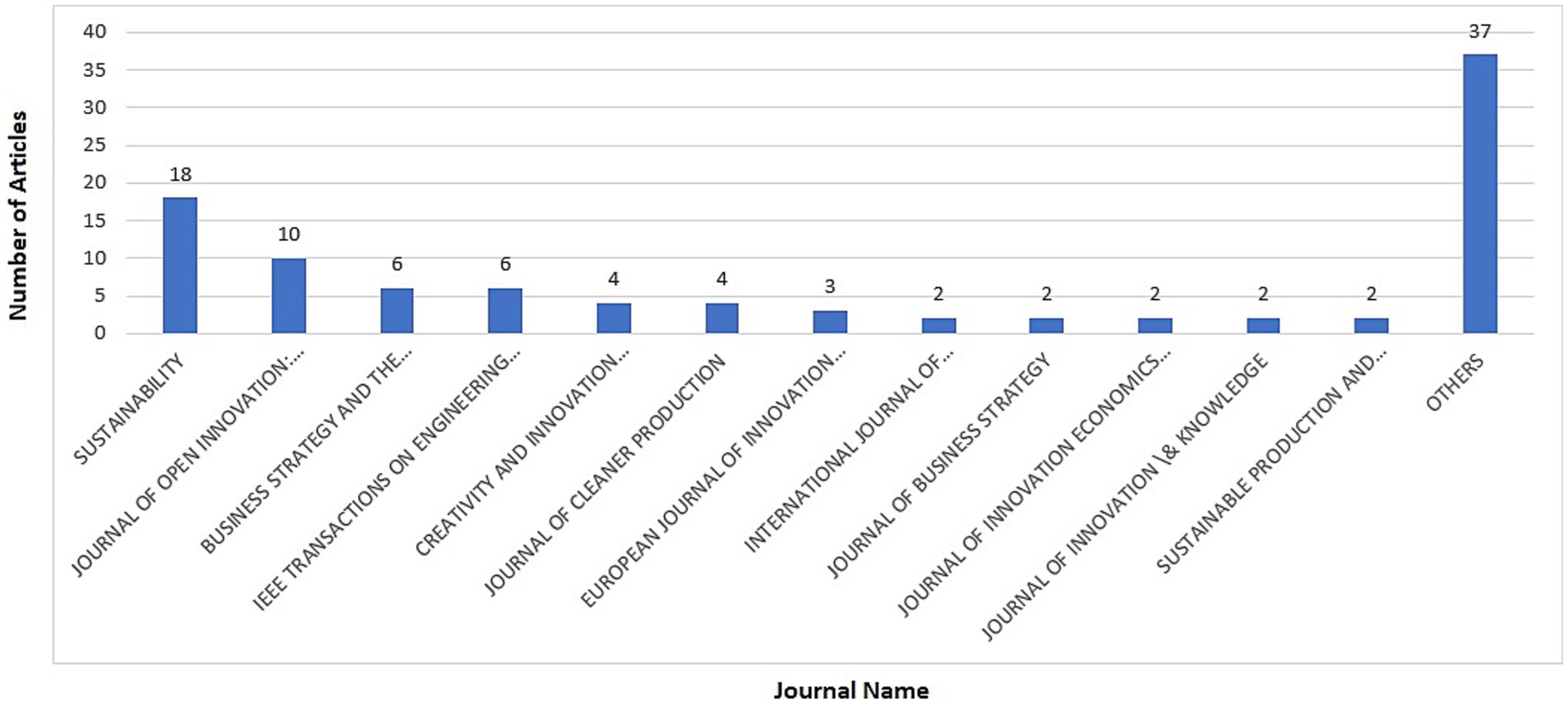
Figure 2. Number of scientific publications on open innovation on circular economy from some popular journals.
The annual scientific production appears to have increased significantly, continuously, and notably since 2020, particularly at the intersection of Open Innovation and Circular Economy, as shown in Figure 3. The sporadic, low annual publications from 2015 to 2019 suggest that the conceptual link between the idea of Open innovation and circular economy was still emerging. Although publication volume increases from 2020 to 2023, it peaks in 2024. The study following this trajectory suggests an increasing academic interest in how Open Innovation practices, in the form of external knowledge collaboration and boundary-spanning innovation, can contribute to the implementation of the Circular Economy, particularly in complex industrial and policy contexts. Congestion in the database and actual deployment in 2025 are likely to decrease due to database indexing delays or partial-year data, which should be interpreted cautiously.
Figure 4 depicts the bibliometric analysis of globally cited documents. It is determined that contributions related to the intersection of sustainability, business strategy, and open innovation are influential and become predominant, with 138 and 137 citations for Brown et al. (2019) and Prause (2015), respectively. In particular, two publications that have recently garnered a high number of citations (104 and 90 in Köhler et al. (2022) and Bocken et al. (2022), respectively) suggest that the current focus on strategic environmental management within circular economy frameworks is on the rise.
Figure 5, which shows the authors’ local impact by H-index, reveals that Bocken, N., possesses the highest influence (H = 6) within the bibliometric landscape of Open innovation and circular economy research, indicating a sustained contribution and significant citation recognition in this thematic area. Authors such as Brown P. (H = 4) and Balkenende R. (H = 3) follow, indicating their prominent role in shaping interdisciplinary dialogues around sustainable innovation and systems integration. The presence of other contributors with lower H-indices (H = 1–2), including Mangla S. and Yun J., suggests a growing diversification and infusion of emerging scholarship within the field.
Figure 6 shows a visualization of country-level citations, revealing dominance by the Netherlands (337 citations), followed by Italy (265) and Spain (213), highlighting Europe’s central role in shaping the scholarly discourse on Open Innovation and the Circular Economy. The significant citation counts from countries such as Estonia, Denmark, and Finland further underscore the strong policy-driven and academically integrated adoption of circular economy principles within European research agendas (Acerbi et al., 2022). The representation of non-European countries such as China (110), Brazil (71), and Canada (71) also indicates a widening global engagement with Open Innovation-Circular Economy themes.
By leveraging trend topic analysis (Figure 7), it is possible to deepen the understanding of thematic development in the evolution of the term, showing that the appearance of buzzwords such as “circular economy, open innovation, collaboration, and business model” began to skyrocket mostly in 2021. This higher frequency of these terms after 2022 indicates that it is changing from a more component (departmental) view to a holistic one, particularly the uptick of the terms: “sustainable development,” “sustainable business model,” and “collaborative innovation” (Eisenreich et al., 2021; Hernández-Chea et al., 2020; Dantas et al., 2022). Since the rise of the notion of “open innovation” linked with “circular economy” in recent years, it has been demonstrated that researchers are starting to search for Open Innovation as a practice of technology, management, or even both, but more and more, as the enabler of sustainable and circular transitions, for instance, in collective ecosystems or innovation networks (Jesus and Jugend, 2021; Tumuyu et al., 2024; Sgambaro et al., 2024).
The fact is further validated by the use of the thematic evolution map (Figure 8), which traces conceptual transitions over time. The research conducted between 2015 and 2023 primarily focused on basic concepts, including “business model innovation” and “sustainable business model.” It was largely exploratory in terms of how innovation can facilitate circularity and the role of actors in this context. Then, on the contrary, the themes of 2024–2025 focus on the applied and network-based dimensions (“collaborative innovation networks,” “SMEs,” and “business models”) as attributes of an emerging research agenda that is maturing and consistently interested in integrating the value networks during the different life cycle phases (Triguero et al., 2022; Eisenreich et al., 2021; Yun et al., 2020). The fact that the “circular economy” theme continues to persist and expand in 2024–2025, together with innovation terms, indicates a growing perception of Open Innovation as a means through which the circular principles can be realized for both the firm and ecosystem levels (Hernández-Chea et al., 2020; Pichlak and Szromek, 2022).
This study presents a framework for the intellectual structure of the research field where open innovation and circular economy intersect, utilizing a co-occurrence network map to reveal this framework, which was created using VOSviewer (Figure 9). This graphical representation, based on keywords extracted from contemporary publications and their co-occurrence, illustrates a perception of fundamental themes and their interrelations, thereby enabling both theoretical understanding and practical application of these constructs. Conceptual relationship between terms is indicated by their proximity and link strength, and the size of every node indicates how often the given keyword is used. The map highlights the complex interconnections between Open Innovation and the Circular Economy over the last 5 years, not only in the fields of sustainability and innovation but also in other areas. To begin with, “open innovation” and “circular economy” are identified as the two most central and important nodes in the map, as they form the base of the scholarly conversation. If two topic words are close and have multiple interlinking edges, then there is a strong thematic coupling. Thus, a critical mass of recent literature investigates how open innovation enables circular transitions as a result of mechanisms associated with co-development of R&D and knowledge spillovers sharing of platforms, etc. De Sousa Jabbour et al. (2020) study argues that Open Innovation, in providing the firms with the enablement to tap into the external knowledge, enhances their Circular Economy practices, such as resource reusing, extending the product life, and reverse logistics (Sergianni et al., 2024).
Second, concepts such as “business model,” “capabilities,” “framework,” “barriers,” and “network” seem to be closely associated within the green and red clusters where Open Innovation and Circular Economy are located, which implies that they are conceptually similar to Open Innovation and Circular Economy. These clusters also indicate that a significant portion of the literature is situated in an area of interest to firms seeking to strategically reconfigure their business models to align with Circular Economy principles while leveraging Open Innovation as the underlying mechanism. According to Geissdoerfer et al. (2020), circular business models are adapted through open methods that necessitate co-creation with stakeholders along value chains (Tumuyu et al., 2024). In the same vein, the presence of “barriers” and “framework” also demonstrates that scholars are carrying out the challenge’s analysis of implementing Open Innovation in circular contexts, which includes organizational resistance, intellectual property issues, and capability gaps (Johnstone, 2024).
Third, mechanisms for operationalizing Open Innovation in Circular Economy transitions are suggested in terms of ‘dynamic capabilities,’ ‘crowdsourcing,’ and ‘collaboration,’ which are situated near both central concepts. Crowdsourcing is a prime example of how firms utilize external knowledge and user-driven innovation to address sustainability challenges. In addition, “dynamic capabilities” imply that a firm’s intrinsic ability to adjust, summarize, and rebuild its resources is crucial in aligning innovation practices with circular principles (Köhler et al., 2022).
Fourth, the blue and yellow clusters support terms such as “supply chain management,” “reverse logistics,” “resource-based view,” and “industry 4.0,” and thus are more applied or technology-oriented. The topics addressed in this review are indicative of the recent trend towards integrating digital technologies and operational strategies to support circular goals. According to Hofmann et al. (2018) and Tseng et al. (2018), the optimization of resource flows, traceability, and new circular business models can be enabled through the combination of open innovation with IoT, AI, and blockchain. Finally, these findings also open the door for future research into circular transitions, particularly the role of digital innovation ecosystems in enabling them.
The final part of the map also indicates some research gaps and future directions. Despite this strong core around Open Innovation and Circular Economy, there are terms on the periphery that include “leadership,” “absorptive capacity,” and “sustainable development goals,” but these are underexplored areas. By doing this, future studies can thus open the door to investigate how leadership, organizational culture, and other organizational factors influence the adoption of open innovation in circular initiatives (Angelis et al., 2023). Furthermore, the limited co-occurrence of the policy-related terms indicates an institutional or regulatory gap. Closing these gaps should help to better understand how Open innovation and circular economy can operate within broader socio-technical systems beyond the firm level.
The overlay visualization map (Figure 10) presents a co-occurrence analysis of keywords, based on the average publication year, to provide insight into the temporal relationship between open innovation and the circular economy. Their color spectrum ranges from purple (older, ~ 2021) to yellow (more recent, ~ 2024), revealing some evolution in research themes over time. From this, several important results of the literature over the last 5 years are highlighted.
First, open innovation and the circular economy are core and long-lived themes of sustainability-related innovation research. The green color indicates that these core terms have been on the green list each year from 2021 to 2022 and that they continue to receive consistent attention. In particular, their position at the center of the map and their high connectivity with other terms in the map indicate that they are both foundational and integrative concepts within this knowledge domain. This is proof that what some scholars have been saying is true, that open innovation is not only a facilitator of circular transition but also a major means to foster cross-boundary cooperation, experimentation, and knowledge recombination (De Jesus and Mendonça, 2018).
In addition, research of recent developments (2023–2024) emphasizes downstream and operational aspects of the circular economy (i.e., reverse logistics, absorptive capacity, and adoption), shaded yellow. Clearly, these emerging topics indicate that scholars are now starting to study how firms practically implement open innovation to enable the Circular Economy at the organizational, as well as at the supply chain level. In addition, the yellow-green range of appearance indicates that strategic and managerial enablers of the Circular Economy through innovation are developing an interest.
Third, “collaborative innovation,” “stakeholder engagement,” and “sustainable business models” (in blue to turquoise) signify a technology as being currently within the scope of scholarly attention (around 2021). It is their somewhat faded color, implying that they may still be conceptually interesting but are no longer at the forefront of new contributions; they have been further explored in earlier phases of research.
Fourth, the emergence of digital technologies—represented through keywords such as Industry 4.0 and capabilities—suggests a growing intersection between technological enablers and the integration of open innovation and the Circular Economy. Future studies may further delve into how digital platforms and data-driven strategies operationalize open innovation in circular ecosystems.
The visualization concludes by depicting the link between open innovation and circular economy as it matures into exploratory frameworks, transitioning to applied, measurable, and technologically enabled methods. Early research emphasized the theoretical synergy between these two ideas, but later studies focused more on performance, integration, and impact.
The thematic map (Figure 11) provides a highly insightful visual representation of the thematic structure of literature on Open innovation and circular economy over the last 5 years. Themes in regard to the motor themes, basic themes, niche themes, and emerging/declining themes are positioned into four quadrants that provide a strategic overview of which of the concepts are relevant, mature, growing, and may be waning in academic discourse in the bottom-right quadrant (heels basic themes), the biggest and most important cluster, with phrases of circular economy, open innovation, sustainability and business models. In some ways, these are the well-established, highly relevant themes that underlie the discipline. Nevertheless, given that all three terms have continued to gain prominence in discussions over recent years, Open Innovation is acknowledged as a major strategic enabler of the Circular Economy, delivering circular business models and achieving sustainable innovation.
This constitutes all terms in the upper right quadrant (motor themes), including “business model innovation,” “dynamic capabilities,” “organizational,” and “sustainable business.” Three of these are highly developed and central to the field, indicating that the current research is driven by structurally and strategically integrating Circular Economy and Open Innovation principles into how firms operate. An example of such an approach is the discussion of how organizational capabilities and dynamic strategies facilitate the alignment of innovation processes with circular principles, as presented by Triguero et al. (2022) and Bocken et al. (2022). The motor themes indicate that scholars are exploring the further of the Open Innovation-Circular Economy nexus, shifting away from conceptual definitions of the Open Innovation-Circular Economy nexus to how firm transformation processes are driven.
In the upper left quadrant (niche themes), there are topics such as “product-service systems,” “product design,” and “circular economy strategies.” Although quite developed, they are not yet central to the larger framework. This implies a focus on a particular thread of research that is highly specialized or tailored for the industry. This interpretation is supported by a recent study by Chaurasia et al. (2020) of how product design and service-based innovation can prolong product lifecycles and promote resource circularity. While these topics are currently niche, they have the potential to become integrated into core discussions over time, benefiting firms in their move toward practical implementation tools for circularity.
“Industry 4.0,” “servitization,” and “industrial symbiosis” fall in the lower left quadrant (emerging or declining themes). These themes, although now of lower density and centrality, are critical to watch. Due to its interpretation of digital technologies as enablers of data sharing and transparency, this is of particular interest regarding Industry 4.0, as these are key elements of open innovation ecosystems, as recently discussed in works such as Sánchez-García et al. (2024). This result is expected to be due to the late incorporation of these themes into Circular Economy-Open Innovation research or a lag in the cross-disciplinary citations. Their appearance indicates that a technological advance bridging the gap between high technology and sustainability transitions is ripe.
Due to the increased complexity and systematization of sustainability problems, which increasingly rely on knowledge and resource sharing beyond organizational boundaries, the integration of Open Innovation into the Circular Economy is motivated as a primary driver. Open Innovation moves firms to seek joint development of solutions beyond in-house capabilities by reaching out to a variety of external stakeholders (suppliers, customers, universities, even competitors) for collaborative product lifecycle extension, use of resources efficiently and in closing material loops (Jesus and Jugend, 2021; Eisenreich et al., 2021; Runiewicz-Wardyn, 2023). For instance, Bocken et al. (2022) emphasize that Open Innovation facilitates business model innovation, which is fundamental to transitioning to circular strategies, such as product-service systems and remanufacturing. Being open in this way increases access for firms to complementary capabilities and speeds the acceptance of circular innovations (Perotti et al., 2024; Sergianni et al., 2024).
It also provides a powerful enabler through technological advancements. The supply chain is enhanced through significant collaborative innovation, combining the use of advanced digital technologies such as the Internet of Things (IoT), blockchain, and artificial intelligence (AI), while addressing deficiencies in data interchange and traceability within supply chains (Yoshino et al., 2023; Jesus et al., 2024; Bitzenis et al., 2025). According to Sánchez-García et al. (2024), convergence between Industry 4.0 and Circular Economy necessitates open, digital ecosystems for the co-creation of innovation. These tools not only strengthen operational efficiency but also ensure transparency and accountability, which are essential requirements of the Circular Economy in a Closed Loop.
As a key driver, the policy landscape is the second most important factor. The Circular Economy is increasingly promoted through regulations, subsidies, public and private research platforms, and similar initiatives by governments and transnational institutions, such as the UN and the World Bank. An external source of pressure on firms to do so is the need to comply with regulations and the pressure of competition. There are several important barriers to integrating Open Innovation into Circular Economy practice. IP protection and trust are two of the most persistent. Companies are often afraid to give away critical knowledge because of the fear of opportunism and IP leakage. Köhler et al. (2022) argue that the absence of formal governance instruments for tracking knowledge flows across organizations may deter organizations from further engaging in open collaborations (Köhler et al., 2022; Hernández-Chea et al., 2020). In fact, in industries where Circular Economy innovation is one of a firm’s core competitive advantages, the issue of Circular Economy conflict becomes particularly interesting.
The second barrier is the organization’s culture and mindset. The Circular Economy and Open Innovation often require a long-term and collaborative approach. In contrast, traditional linear thinking and short-term profit-oriented views, as well as the continuation of internal R&D dominance, often conflict. As highlighted by Triguero et al. (2022), many firms, particularly some SMEs, still view Open Innovation as risky or unnecessary due to a lack of absorptive capacity. Furthermore, decision-makers lack digital literacy, and internal resistance to change delays the adoption of integrated strategies. SMEs, while more agile, often struggle with financial resources and human capital necessary to sustain Open Innovation efforts (Yoshino et al., 2023).
Integrating Open Innovation into the practice of Circular Economy can be a good route to achieve sustainable transformation, but this does not mean this process is faultless. To overcome these obstacles, a comprehensive approach is necessary to establish trust-based governance frameworks, implement circular education, and foster collaboration through policy and digital platforms. Subsequent research should investigate the empirical characteristics of sector-specific dynamics and the mechanisms through which emerging digital ecosystems may facilitate their emergence or transformation.
Discussion
The visualization of co-occurring keywords provides critical insight into changes in research of Open innovation and circular economy Interrelating. Terms such as “open innovation,” “circular economy,” “innovation,” and “business models” are very foundational to this domain, playing their parts as one of the components on top of which this domain is built, being placed in the central position. The average publication year is around 2022, as indicated by the green shading, which reflects a long and increasingly sustained scholarly exploration of Open Innovation-Circular Economy intersections (Runiewicz-Wardyn, 2023; López-Pérez et al., 2023).
Newly issued terms such as “absorptive capacity,” “reverse logistics,” “adoption,” “transition,” and “leadership,” in yellow, reflect a growing move toward applied organizational enablers. Recent studies contain these keywords, which imply a practical orientation in operationalizing the Circular Economy through Open Innovation; that is, the mechanisms by which firms operationalize the Circular Economy through Open Innovation. For instance, absorptive capacity is a widely acknowledged dynamic capability core for integrating external knowledge for circular innovation (Stettler et al., 2024). Frauenthal Automotive Toruń illustrates how SMEs apply absorptive capacity by integrating external knowledge through collaborations and digital tools to drive cleaner production and innovation (Lis and Sudolska, 2015). This aligns with bibliometric findings, which highlight absorptive capacity as a central theme in the open innovation-circular economy nexus, emphasizing its practical relevance for knowledge-driven sustainability transitions in manufacturing sectors.
Meanwhile, Patagonia exemplifies sustainability-oriented leadership by integrating environmental values into its core strategy through initiatives such as repair, reuse, and stakeholder engagement. This real-world case supports bibliometric findings that highlight leadership, particularly transformational and purpose-driven styles, as critical enablers of circular innovation (Rattalino, 2018), guiding organizations to align a long-term vision with the principles of open innovation and circular economy. Similarly, reverse logistics can be considered an important element of resource recovery and closed-loop manufacturing systems and is closely connected with digital and collaborative innovation frameworks (Rasool et al., 2023). HP’s Planet Partners program exemplifies this by collecting and recycling over 3.8 billion cartridges through a global closed-loop system (Ellen MacArthur Foundation, 2021). This real-world case reinforces the literature’s view of reverse logistics as essential for sustainable, innovation-driven resource recovery.
The blue or purple earlier-phase concepts, such as “stakeholder engagement,” “dynamic capabilities,” and “bibliometric analysis,” express an emphasis on the theories that establish a new discipline. Keywords central to the study, such as “collaboration,” “performance,” and “framework,” serve to connect to both the foundational theory and the new empirical applications. More and more terms, such as “eco-innovation” and “environmental innovation,” are increasingly gaining prominence, indicating the convergence of these concepts: Open Innovation as a system enabler of sustainable transition (not merely as a business strategy) (Dorrego-Viera et al., 2025). It shows a greater interest in the environmental performance outcomes of open, collaborative responses. Fundamentally, the overlay map represents a paradigmatic shift from theoretical foundations in Open Innovation-Circular Economy research (“what,” and “why”) to operational models in Open Innovation-Circular Economy (“how”). Related to this, this improvement aligns with the actual policy and academic requirements in a way that supports circular transformation and is scalable and innovation-driven.
The convergence of Open Innovation and the Circular Economy represents a key step in modern sustainability research. This study contributes to the evolving field by employing bibliometric methods to explore the literature spanning the years 2015–2025. Through a synthesis of performance analysis and science mapping using Bibliometrix and VOSviewer, it can be described how single-focused discussions in the past have now formed a connected and practical research plan. Originally, Open Innovation emerged as a strategic model advocating the purposive inflow and outflow of knowledge across organizational boundaries (Chesbrough, 2003), while Circular Economy was designed as a systemic response to the failures of the linear economy, emphasizing resource efficiency and waste reduction. Despite starting separately, the two domains are moving towards unity as they respond to pressing environmental problems and the rapid spread of digitalization (Bocken and Ritala, 2021; Jesus et al., 2024).
This convergence is supported by the results of the bibliometric mapping, which highlight three critical factors that enable Open Innovation to support Circular Economy outcomes: enhancing innovation, fostering teamwork with stakeholders, and increasing organizational adaptability. They primarily focus on groups of ideas such as reverse logistics, absorptive capacity, and digital collaboration networks. All of this adds up to a major step. Open Innovation now drives innovation and serves as a key enabler for circular transformation in different areas. Aside from contributions, several factors need to be considered, such as the research not including grey literature or any unindexed local studies, which might provide additional nuance, as it solely uses Scopus and Web of Science data as databases. Due to these constraints, qualitative case studies and ethnographic studies play a crucial role.
This study has identified numerous new opportunities for future study. It may be useful for empirical studies to analyze the overall effect of sectoral particularities on practices in the global Circular Economy, highlighting each industry’s unique roles, especially those of electronics, fashion, and construction. SMEs require special attention, as their flexibility and restraints demonstrate how circular Open Innovation methods can be scaled up. Theoretically, there is scope to develop integrative frameworks such as “Open Circular Platforms”—digitally enabled infrastructures designed to facilitate stakeholder co-creation and data-driven decision-making within circular ecosystems. Comparative studies across different geographies could enrich our understanding of how national innovation systems and regulatory landscapes influence the effectiveness of Open Innovation in promoting Circular Economy adoption.
Technology is another cornerstone of this evolving discourse. Innovations such as blockchain, artificial intelligence, and digital twins promise to enhance traceability, efficiency, and transparency within circular systems. With digital twins, it is possible in the Circular Economy to preview reuse and remanufacturing strategies, track shipments throughout the entire supply chain, and receive ongoing information for informed decision-making and future advancements. Including them in Open Innovation models enables users to view and assess circular innovations, thereby facilitating systemic transformations. New tools, such as blockchain and AI, also enhance these abilities by promoting transparency and facilitating effective resource management, which are essential for the circular economy. Further study is needed on how these technologies align with Open Innovation principles and actions focused on fostering innovation ecosystems.
Finally, this study confirms the value of integrating Open Innovation with Circular Economy frameworks and provides a solid foundation for further study and application. Open, joint, and digitally supported innovation ecosystems will play a crucial role in helping the next generation achieve a circular shift. Future research can strengthen, enrich, and contextualize the discussion to address various groups and areas.
Conclusion
This study explores the interconnection between Open innovation and circular economy through a comprehensive synthesis of their evolving relationship. Open Innovation is demonstrated to be a key enabler of the success of Circular Economy models, facilitating collaboration, accelerating knowledge exchange, and serving as a catalyst for cross-sector innovation. A chronological review of the literature reveals a growing interest in the academic and practical application of Open Innovation strategies in addressing the systemic challenges of implementing the Circular Economy, particularly in resource-intensive manufacturing industries (Perotti et al., 2024).
This study addresses the second research objective and identifies the critical predictive variables, drivers, and barriers that may lead to the adoption of Open Innovation in the Circular Economy. The key drivers for this are technological readiness, stakeholder involvement, regulatory support, and an organizational culture that is supportive of innovation and sustainability (Eisenreich et al., 2021; Runiewicz-Wardyn, 2023). On the other hand, significant barriers exist regarding intellectual property concerns, the lack of standard metrics, organizational resistance, and insufficient investment in the innovation ecosystem (Hernández-Chea et al., 2020). These insights pave the way for policymakers, practitioners, and researchers to consider, leading to the design of more resilient, scalable, and effective Circular Economy initiatives facilitated through open and collaborative innovation models (Yoshino et al., 2023; Dantas et al., 2022).
Therefore, this research addresses a critical gap in the literature by not only mapping the historical exchange between Open Innovation and Circular Economy, but also laying the groundwork for future integration in a balanced manner. This study contributes theoretically to understanding how Open Innovation mechanisms can facilitate Circular Economy transitions by highlighting underutilized theoretical dimensions, including enhanced innovation capability, improved stakeholder engagement, and greater organizational capacity. Practically, it offers insights for organizations, policymakers, and other ecosystem actors seeking to implement circular strategies through open and collaborative innovation.
However, the study has limitations. First, it is restricted to publications indexed in major academic databases and may have excluded relevant grey literature or non-English sources. Second, while bibliometric tools provide robust quantitative mapping, they do not capture the full depth of theoretical nuance, which may limit interpretive richness. Third, the rapidly evolving nature of this field means that newer publications, especially those published toward the end of the dataset, may not yet have accrued sufficient citations to be fully represented in the analysis. Future research should consider complementing bibliometric approaches with qualitative content analysis or case studies to deepen theoretical insights. Additionally, scholars are encouraged to explore cross-sectoral and regional applications of open innovation in the circular economy, investigate the role of digital and social innovation platforms, and empirically test the effectiveness of proposed frameworks in different organizational and policy contexts.
Data availability statement
The raw data supporting the conclusions of this article will be made available by the authors without undue reservation.
Author contributions
DS: Data curation, Writing – original draft, Formal analysis, Methodology, Software, Visualization, Validation, Resources, Investigation, Writing – review & editing, Conceptualization, Project administration. RR: Supervision, Writing – review & editing. MH: Writing – review & editing, Supervision. SC: Writing – review & editing, Supervision. WG: Writing – review & editing, Supervision.
Funding
The author(s) declare that no financial support was received for the research and/or publication of this article.
Conflict of interest
The authors declare that the research was conducted in the absence of any commercial or financial relationships that could be construed as a potential conflict of interest.
Generative AI statement
The author(s) declare that no Gen AI was used in the creation of this manuscript.
Publisher’s note
All claims expressed in this article are solely those of the authors and do not necessarily represent those of their affiliated organizations, or those of the publisher, the editors and the reviewers. Any product that may be evaluated in this article, or claim that may be made by its manufacturer, is not guaranteed or endorsed by the publisher.
References
Acerbi, F., Sassanelli, C., and Taisch, M. (2022). A conceptual data model promoting data-driven circular manufacturing. Oper. Manag. Res. 15, 838–857. doi: 10.1007/s12063-022-00271-x
Ahmad, S., Daddi, T., and Iraldo, F. (2024). Integration of open innovation, circularity and sustainability: a systematic mapping of connections, analysis of indicators and future prospects. Creat. Innov. Manag. 33, 414–437. doi: 10.1111/caim.12598
Álvarez-Meaza, I., Pikatza-Gorrotxategi, N., and Belver, R. (2020). Sustainable business model based on open innovation: case study of Iberdrola. Sustain. For. 12:10645. doi: 10.3390/su122410645
Angelis, R., Morgan, R., and Luca, L. (2023). Open strategy and dynamic capabilities: a framework for circular economy business models research. Bus. Strateg. Environ. 32, 4861–4873. doi: 10.1002/bse.3397
Aria, M., and Cuccurullo, C. (2017). Bibliometrix: an R-tool for comprehensive science mapping analysis. J. Inform. 11, 959–975. doi: 10.1016/j.joi.2017.08.007
Birkle, C., Pendlebury, D. A., Schnell, J., and Adams, J. (2020). Web of science as a data source for research on scientific and scholarly activity. Quant. Sci. Stud. 1, 363–376. doi: 10.1162/qss_a_00018
Bitzenis, A., Κοutsoupias, Ν., and Nosios, M. (2025). Artificial intelligence and machine learning in production efficiency enhancement and sustainable development: a comprehensive bibliometric review. Front. Sustain. 5:1508647. doi: 10.3389/frsus.2024.1508647
Bocken, N. M. P., Harsch, A., and Weissbrod, I. (2022). Circular business models for the fastmoving consumer goods industry: desirability, feasibility, and viability. Sustain. Prod. Consum. 30, 799–814. doi: 10.1016/j.spc.2022.01.012
Bocken, N., and Ritala, P. (2021). Six ways to build circular business models. J. Bus. Strateg. 43, 184–192. doi: 10.1108/jbs-11-2020-0258
Brown, P., Bocken, N., and Balkenende, R. (2019). Why do companies pursue collaborative circular oriented innovation? Sustain. For. 11:635. doi: 10.3390/su11030635
Brown, P., Bocken, N., and Balkenende, R. (2020). How do companies collaborate for circular oriented innovation? Sustain. For. 12:1648. doi: 10.3390/su12041648
Bulto, T. W., Chebo, A. K., Regassa, H. F., Werku, B. C., and Kloos, H. (2025). Scientific mapping of the nexus between entrepreneurial orientation and environmental sustainability: bibliometric analysis. Front. Sociol. 9:1464840. doi: 10.3389/fsoc.2024.1461840
Calabrese, A., Costa, R., Haqbin, A., Ghiron, N., and Tiburzi, L. (2024). How do companies adopt open innovation to enable circular economy? Insights from a qualitative meta-analysis of case studies. Bus. Strateg. Environ. 33, 6852–6868. doi: 10.1002/bse.3848
Chaurasia, S., Kaul, N., Yadav, B., and Shukla, D. (2020). Open innovation for sustainability through creating shared value-role of knowledge management system, openness and organizational structure. J. Knowl. Manag. 24, 2491–2511. doi: 10.1108/JKM-04-2020-0319
Chesbrough, H. (2003). The new imperative for creating and profiting from technology. Massachusetts, USA: Harvard Business School Press.
Dantas, R., Ilyas, A., and Rita, J. (2022). Circular entrepreneurship in emerging markets through the lens of sustainability. J. Open Innov.: Technol. Mark. Complex. 8:211. doi: 10.3390/joitmc8040211
De Jesus, A., and Mendonça, S. (2018). Lost in transition? Drivers and barriers in the eco-innovation road to the circular economy. Ecol. Econ. 145, 75–89. doi: 10.1016/j.ecolecon.2017.08.001
De Sousa Jabbour, A. B. L., de Oliveira Frascareli, F. C., and Foropon, C. (2020). When titans meet—can industry 4.0 revolutionize the environmentally-sustainable manufacturing wave? The role of critical success factors. Technol. Forecast. Soc. Change 132, 18–25. doi: 10.1016/j.techfore.2018.01.017
Donthu, N., Kumar, S., Mukherjee, D., Pandey, N., and Lim, W. M. (2021). How to conduct a bibliometric analysis: an overview and guidelines. J. Bus. Res. 133, 285–296. doi: 10.1016/j.jbusres.2021.04.070
Dorrego-Viera, J. I., Urbinati, A., and Lazzarotti, V. (2025). Transition towards circular economy: exploiting open innovation for circular product development. J. Innov. Knowl. 10:100668. doi: 10.1016/j.jik.2025.100668
Eisenreich, A., Füller, J., and Stuchtey, M. (2021). Open circular innovation: how companies can develop circular innovations in collaboration with stakeholders. Sustain. For. 13:13456. doi: 10.3390/su132313456
Ellen MacArthur Foundation (2021). Creating a reverse logistics ecosystem: HP Brazil & Sinctronics. Available online at: https://www.ellenmacarthurfoundation.org/circular-examples/creating-a-reverse-logistics-ecosystem (Accessed May 30, 2025).
Gao, Y., Lin, R., and Lu, Y. (2022). A visualized analysis of the research current hotspots and trends on innovation chain based on the knowledge map. Sustain. For. 14:1708. doi: 10.3390/su14031708
Geissdoerfer, M., Pieroni, M. P. P., Pigosso, D. C. A., and Soufani, K. (2020). Circular business models: a review. J. Clean. Prod. 277:123741. doi: 10.1016/j.jclepro.2020.123741
Hernández-Chea, R., Vimalnath, P., Bocken, N., Tietze, F., and Eppinger, E. (2020). Integrating intellectual property and sustainable business models: the SBM-IP canvas. Sustain. For. 12:8871. doi: 10.3390/su12218871
Hofmann, F., Schleper, M. C., and Blome, C. (2018). Conflict minerals and supply chain due diligence: an exploratory study of multi-tier supply chains. J. Bus. Ethics 147, 115–141. doi: 10.1007/s10551-015-2963-z
Jesus, G., and Jugend, D. (2021). How can open innovation contribute to circular economy adoption? Insights from a literature review. Eur. J. Innov. Manag. 26, 65–98. doi: 10.1108/ejim-01-2021-0022
Jesus, G. M. K., Jugend, D., de Camargo Fiorini, P., and de Sousa Mendes, G. H. (2024). Open innovation to scale up the circular economy: exploring the mediating role of industry 4.0 technologies. Creat. Innov. Manag. 34, 125–142. doi: 10.1111/caim.12629
Johnstone, L. (2024). Strategising for the circular economy through servitisation. J. Serv. Mark. 38, 17–31. doi: 10.1108/JSM-10-2023-0395
Köhler, J., Sönnichsen, S., and Beske-Jansen, P. (2022). Towards a collaboration framework for circular economy: the role of dynamic capabilities and open innovation. Bus. Strateg. Environ. 31, 2700–2713. doi: 10.1002/bse.3000
Krmela, A., Šimberová, I., and Babiča, V. (2022). Dynamics of business models in industry-wide collaborative networks for circularity. J. Open Innov.: Technol. Mark. Complex. 8:3. doi: 10.3390/joitmc8010003
Lis, A., and Sudolska, A. (2015). Absorptive capacity and its role for the company growth and competitive advantage: the case of Frauenthal automotive Toruń company. J. Entrep. Manag. Innov. 11, 63–91. doi: 10.7341/20151143
Lisi, S., Mignacca, B., Grimaldi, M., and Greco, M. (2024). Unpacking the relationship between circular economy and interorganizational collaboration: an exploratory study and an analytical framework. IEEE Trans. Eng. Manag. 71, 14083–14097. doi: 10.1109/TEM.2024.3437772
López-Pérez, G., García Sánchez, I. M., and Zafra Gómez, J. L. (2023). A systematic literature review and bibliometric analysis of eco-innovation on financial performance: identifying barriers and drivers. Bus. Strateg. Environ. 33, 1321–1340. doi: 10.1002/bse.3550
Mamedova, N., Bezveselnaya, Z., Ivleva, M., and Кomarova, V. (2022). Environmental management for sustainable business development. Entrep. Sustain. Issues 9, 134–151. doi: 10.9770/jesi.2022.9.3(9)
Payán-Sánchez, B., Ureña, L., Plaza-Úbeda, J., Vázquez-Brust, D., Yakovleva, N., and Pérez-Valls, M. (2021). Open innovation for sustainability or not: literature reviews of global research trends. Sustain. For. 13:1136. doi: 10.3390/su13031136
Perotti, F., Bargoni, A., Bernardi, P., and Rózsa, Z. (2024). Fostering circular economy through open innovation: insights from multiple case study. Bus. Ethics Environ. Respons. 34, 390–408. doi: 10.1111/beer.12657
Pichlak, M., and Szromek, A. (2022). Linking eco-innovation and circular economy—a conceptual approach. J. Open Innov.: Technol. Mark. Complex. 8:121. doi: 10.3390/joitmc8030121
Prause, G. (2015). Sustainable business models and structures for industry 4.0. J. Secur. Sustain. Issues 5, 159–169. doi: 10.9770/jssi.2015.5.2(3)
Qing, L., Chun, D., Ock, Y.-S., Dagestani, A. A., and Ma, X. (2022). What myths about green technology innovation and financial performance’s relationship? A bibliometric analysis review. Economies 10:92. doi: 10.3390/economies10040092
Rahmat, D., Rumanti, A., Pulungan, M., Rizaldi, A., and Amelia, M. (2024). Evaluating the role of open innovation and circular economy in enhancing organizational performance: insights from batik small and medium enterprises in Banyuwangi, Indonesia. Sustain. For. 16:11194. doi: 10.3390/su162411194
Rasool, F., Buso, M., Greco, L. G., Morales-Alonso, G., and Carrasco-Gallego, R. (2023). The effect of reverse logistics adoption on digitalization and inter-organizational collaboration. Int. J. Phys. Distrib. Logist. Manag. 53, 563–588. doi: 10.1108/IJPDLM-06-2022-0173
Rattalino, F. (2018). Circular advantage anyone? Sustainability-driven innovation and circularity at Patagonia, Inc. Thunderbird Int. Bus. Rev. 60, 747–755. doi: 10.1002/tie.21917
Razalli, M., Rahim, M., Noordin, A., Kafi, A., Lateh, A., Yusuf, M., et al. (2024). Global trends of circular economy and innovation research: a bibliometric analysis. Int. J. Sustain. Dev. Plan. 19, 4527–4537. doi: 10.18280/ijsdp.191202
Runiewicz-Wardyn, M. (2023). Linking circular innovation with ‘open innovation’ paradigm: a stakeholder approach. Circ. Econ. 1, 1–6. doi: 10.55845/UTDS4006
Sánchez-García, E., Martínez-Falcó, J., Marco-Lajara, B., and Gigauri, I. (2024), Building the future through digital entrepreneurship and innovation, Eur. J. Innov. Manag. doi: 10.1108/EJIM-04-2024-0360 [Epub ahead of print].
Sergianni, L., Chiara, A., and Mauro, S. (2024). Open innovation as fuel for the circular economy: an analysis of the Italian context. J. Innov. Manag. 12, 188–204. doi: 10.24840/2183-0606_012.001_0009
Sgambaro, L., Chiaroni, D., and Urbinati, A. (2024). Fostering the transition towards circular economy through collaborations: an open innovation perspective in the building industry. Creat. Innov. Manag. 34, 30–46. doi: 10.1111/caim.12623
Sondhi, S., Salwan, P., Niranjan, S., Hawkins, T., Behl, A., Pereira, V., et al. (2024). Exploring open innovation dynamics: service and delivery interplay in circular economy. IEEE Trans. Eng. Manag. 71, 15511–15524. doi: 10.1109/TEM.2024.3483750
Stettler, T. R., Moosauer, E. J., Schweiger, S. A., Baldauf, A., and Audretsch, D. B. (2024). Absorptive capacity in a more (or less) absorptive environment: a meta-analysis of contextual effects on firm innovation. J. Prod. Innov. Manag. 42:12758. doi: 10.1111/jpim.12758
Triguero, Á., Cuerva, M., and Sáez-Martínez, F. (2022). Closing the loop through eco-innovation by European firms: circular economy for sustainable development. Bus. Strateg. Environ. 31, 2337–2350. doi: 10.1002/bse.3024
Tseng, M. L., Chiu, A. S. F., Chien, C. F., Tan, R. R., and Ji, P. (2018). Circular economy meets industry 4.0: can big data drive industrial symbiosis? Resour. Conserv. Recycl. 131, 146–147. doi: 10.1016/j.resconrec.2017.12.028
Tumuyu, S., Marthalia, L., and Asteria, D. (2024). Transition thinking for circular agrobusiness innovation - a study case on agroindustry company at Sumatera Island, Indonesia. Int. J. Sustain. Dev. Plan. 19, 609–618. doi: 10.18280/ijsdp.190218
van Eck, N. J., and Waltman, L. (2010). Software survey: VOSviewer, a computer program for bibliometric mapping. Scientometrics 84, 523–538. doi: 10.1007/s11192-009-0146-3
Venturelli, A., Caputo, A., Pizzi, S., and Valenza, G. (2022). A dynamic framework for sustainable open innovation in the food industry. Br. Food J. 124, 1895–1911. doi: 10.1108/BFJ-03-2021-0293
Wei, Y., Wei, X., Ye, Z., and Fan, J. (2025). A bibliometric analysis of food security and urbanization: insights and implications. Front. Sustain. Cities 7:1459493. doi: 10.3389/frsc.2025.1459493
Yoshino, M., Sadlek, B., Yarime, M., and Ali, A. (2023). Knowledge absorption pathways for eco-innovation: an empirical analysis of small and medium-sized enterprises in the European Union. Eur. J. Innov. Manag. 28, 426–453. doi: 10.1108/ejim-02-2023-0136
Yun, J., and Zhao, X. (2020). Business model innovation through a rectangular compass: from the perspective of open innovation with mechanism design. J. Open Innov.: Technol. Mark. Complex. 6:131. doi: 10.3390/joitmc6040131
Keywords: open innovation, circular economy, bibliometric analysis, sustainable business models, innovation capability, stakeholder engagement, organizational capability
Citation: Surya D, Rahim RK, Hamsal M, Candra S and Gunadi W (2025) Mapping the nexus between open innovation and circular economy: a decade of bibliometric evidence. Front. Sustain. 6:1638284. doi: 10.3389/frsus.2025.1638284
Edited by:
Konstantinos Salonitis, Cranfield University, United KingdomReviewed by:
Lingli Qing, Guangzhou College of Commerce, ChinaMalgorzata Runiewicz Wardyn, Kozminski University, Poland
Copyright © 2025 Surya, Rahim, Hamsal, Candra and Gunadi. This is an open-access article distributed under the terms of the Creative Commons Attribution License (CC BY). The use, distribution or reproduction in other forums is permitted, provided the original author(s) and the copyright owner(s) are credited and that the original publication in this journal is cited, in accordance with accepted academic practice. No use, distribution or reproduction is permitted which does not comply with these terms.
*Correspondence: Djoni Surya, ZGpvbmkuc3VyeWFAYmludXMuYWMuaWQ=
 Djoni Surya
Djoni Surya Rano Kartono Rahim
Rano Kartono Rahim Mohammad Hamsal
Mohammad Hamsal Sevenpri Candra
Sevenpri Candra Willy Gunadi
Willy Gunadi